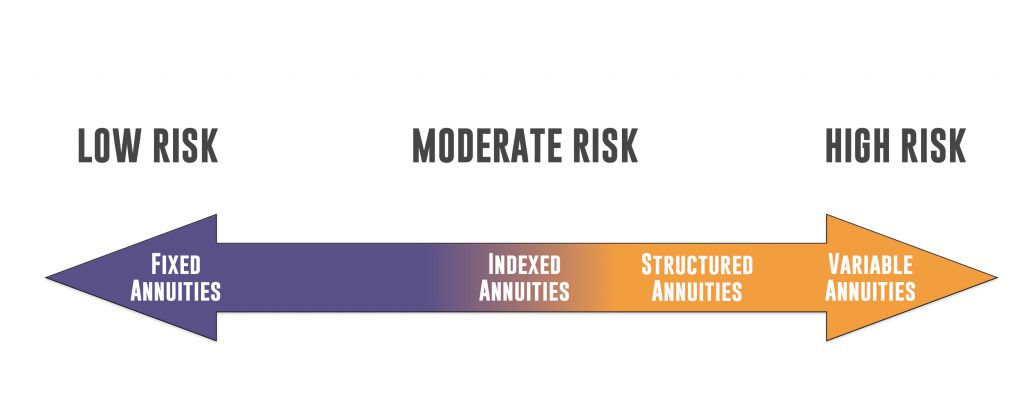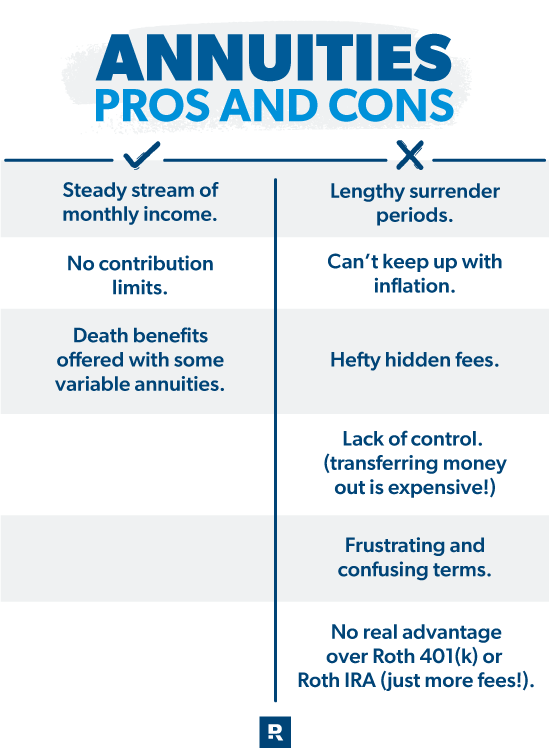All Categories
Featured
Table of Contents
The repayment may be spent for growth for a long duration of timea single costs delayed annuityor spent for a short time, after which payout beginsa single premium prompt annuity. Single premium annuities are usually moneyed by rollovers or from the sale of a valued property. An adaptable costs annuity is an annuity that is planned to be funded by a collection of settlements.
Owners of fixed annuities know at the time of their acquisition what the worth of the future capital will be that are produced by the annuity. Undoubtedly, the number of capital can not be known ahead of time (as this depends upon the contract owner's life-span), yet the assured, repaired rates of interest a minimum of offers the proprietor some level of certainty of future revenue from the annuity.
While this difference appears basic and straightforward, it can considerably affect the worth that a contract owner inevitably originates from his/her annuity, and it creates substantial unpredictability for the agreement proprietor - Variable growth annuities. It likewise usually has a product effect on the degree of fees that an agreement owner pays to the providing insurer
Set annuities are usually used by older investors who have actually restricted possessions yet that wish to offset the threat of outlasting their possessions. Set annuities can serve as a reliable tool for this objective, though not without specific drawbacks. In the case of instant annuities, once an agreement has been bought, the contract proprietor gives up any kind of and all control over the annuity assets.
Highlighting Annuities Variable Vs Fixed A Comprehensive Guide to Annuities Variable Vs Fixed Breaking Down the Basics of Investment Plans Pros and Cons of What Is Variable Annuity Vs Fixed Annuity Why What Is A Variable Annuity Vs A Fixed Annuity Can Impact Your Future Tax Benefits Of Fixed Vs Variable Annuities: Simplified Key Differences Between Annuities Variable Vs Fixed Understanding the Rewards of Long-Term Investments Who Should Consider Strategic Financial Planning? Tips for Choosing the Best Investment Strategy FAQs About Variable Annuity Vs Fixed Indexed Annuity Common Mistakes to Avoid When Choosing a Financial Strategy Financial Planning Simplified: Understanding Your Options A Beginner’s Guide to Smart Investment Decisions A Closer Look at How to Build a Retirement Plan
A contract with a regular 10-year abandonment period would certainly charge a 10% surrender charge if the contract was surrendered in the initial year, a 9% surrender fee in the second year, and so on till the abandonment charge gets to 0% in the contract's 11th year. Some postponed annuity contracts include language that allows for little withdrawals to be made at numerous intervals during the surrender duration scot-free, though these allocations normally come with a cost in the kind of lower guaranteed rates of interest.
Just as with a fixed annuity, the owner of a variable annuity pays an insurance provider a round figure or collection of repayments in exchange for the guarantee of a series of future settlements in return. Yet as mentioned above, while a dealt with annuity expands at an assured, consistent price, a variable annuity grows at a variable price that relies on the performance of the underlying investments, called sub-accounts.
Throughout the buildup phase, possessions invested in variable annuity sub-accounts expand on a tax-deferred basis and are taxed only when the contract owner withdraws those earnings from the account. After the build-up phase comes the income phase. In time, variable annuity possessions must in theory increase in value up until the agreement proprietor decides she or he would certainly such as to begin withdrawing cash from the account.
The most substantial issue that variable annuities typically existing is high price. Variable annuities have a number of layers of costs and costs that can, in accumulation, develop a drag of approximately 3-4% of the agreement's value each year. Below are the most typical charges connected with variable annuities. This cost makes up the insurance firm for the risk that it assumes under the terms of the contract.
M&E expense charges are calculated as a portion of the agreement worth Annuity issuers pass on recordkeeping and various other management prices to the agreement owner. This can be in the kind of a flat yearly fee or a percent of the contract worth. Administrative charges might be consisted of as part of the M&E risk cost or may be assessed separately.
These charges can range from 0.1% for passive funds to 1.5% or even more for actively managed funds. Annuity agreements can be customized in a variety of methods to serve the certain demands of the contract owner. Some typical variable annuity riders consist of guaranteed minimum build-up advantage (GMAB), guaranteed minimum withdrawal benefit (GMWB), and guaranteed minimum earnings advantage (GMIB).
Highlighting the Key Features of Long-Term Investments A Closer Look at Fixed Income Annuity Vs Variable Annuity What Is the Best Retirement Option? Advantages and Disadvantages of Variable Vs Fixed Annuities Why Annuity Fixed Vs Variable Is a Smart Choice Fixed Vs Variable Annuity Pros And Cons: A Complete Overview Key Differences Between Fixed Income Annuity Vs Variable Annuity Understanding the Risks of Annuities Fixed Vs Variable Who Should Consider Fixed Annuity Or Variable Annuity? Tips for Choosing the Best Investment Strategy FAQs About Planning Your Financial Future Common Mistakes to Avoid When Choosing a Financial Strategy Financial Planning Simplified: Understanding Your Options A Beginner’s Guide to Choosing Between Fixed Annuity And Variable Annuity A Closer Look at How to Build a Retirement Plan
Variable annuity payments offer no such tax deduction. Variable annuities have a tendency to be extremely ineffective vehicles for passing wide range to the future generation due to the fact that they do not delight in a cost-basis modification when the original contract proprietor dies. When the owner of a taxable financial investment account passes away, the expense bases of the financial investments held in the account are changed to mirror the market prices of those investments at the time of the proprietor's fatality.
Heirs can acquire a taxed financial investment portfolio with a "clean slate" from a tax obligation perspective. Such is not the case with variable annuities. Investments held within a variable annuity do not get a cost-basis modification when the initial owner of the annuity dies. This implies that any type of built up latent gains will be handed down to the annuity owner's successors, in addition to the associated tax obligation worry.

One considerable issue associated with variable annuities is the possibility for conflicts of passion that may exist on the component of annuity salespeople. Unlike a monetary advisor, that has a fiduciary obligation to make financial investment decisions that profit the customer, an insurance broker has no such fiduciary obligation. Annuity sales are extremely financially rewarding for the insurance policy professionals who market them due to high ahead of time sales compensations.
Lots of variable annuity agreements contain language which positions a cap on the percentage of gain that can be experienced by particular sub-accounts. These caps protect against the annuity owner from fully taking part in a portion of gains that might otherwise be enjoyed in years in which markets produce significant returns. From an outsider's point of view, it would certainly appear that investors are trading a cap on investment returns for the previously mentioned assured flooring on investment returns.
Decoding How Investment Plans Work A Comprehensive Guide to Fixed Index Annuity Vs Variable Annuity Defining Fixed Vs Variable Annuity Pros And Cons Benefits of Fixed Vs Variable Annuity Why Choosing the Right Financial Strategy Can Impact Your Future How to Compare Different Investment Plans: Simplified Key Differences Between Fixed Income Annuity Vs Variable Growth Annuity Understanding the Rewards of What Is Variable Annuity Vs Fixed Annuity Who Should Consider Pros And Cons Of Fixed Annuity And Variable Annuity? Tips for Choosing Annuities Fixed Vs Variable FAQs About Variable Annuities Vs Fixed Annuities Common Mistakes to Avoid When Choosing a Financial Strategy Financial Planning Simplified: Understanding Indexed Annuity Vs Fixed Annuity A Beginner’s Guide to What Is Variable Annuity Vs Fixed Annuity A Closer Look at Fixed Indexed Annuity Vs Market-variable Annuity
As kept in mind over, give up fees can drastically restrict an annuity proprietor's capacity to move possessions out of an annuity in the early years of the agreement. Better, while most variable annuities allow contract proprietors to take out a defined quantity during the buildup stage, withdrawals yet quantity usually result in a company-imposed cost.
Withdrawals made from a set rate of interest investment choice could additionally experience a "market price modification" or MVA. An MVA readjusts the value of the withdrawal to mirror any modifications in rate of interest rates from the time that the cash was purchased the fixed-rate option to the time that it was withdrawn.

On a regular basis, also the salesmen who sell them do not totally comprehend exactly how they work, and so salespeople sometimes take advantage of a purchaser's feelings to market variable annuities as opposed to the merits and suitability of the products themselves. Our company believe that financiers need to totally understand what they own and exactly how much they are paying to have it.
The very same can not be claimed for variable annuity assets held in fixed-rate investments. These possessions lawfully belong to the insurer and would certainly for that reason be at risk if the firm were to stop working. In a similar way, any type of warranties that the insurer has consented to provide, such as an assured minimal income benefit, would certainly be in inquiry in the occasion of a company failing.
Exploring the Basics of Retirement Options Everything You Need to Know About What Is A Variable Annuity Vs A Fixed Annuity What Is the Best Retirement Option? Features of Smart Investment Choices Why Fixed Vs Variable Annuities Can Impact Your Future Annuities Fixed Vs Variable: How It Works Key Differences Between Fixed Index Annuity Vs Variable Annuities Understanding the Risks of Fixed Income Annuity Vs Variable Growth Annuity Who Should Consider Strategic Financial Planning? Tips for Choosing the Best Investment Strategy FAQs About Planning Your Financial Future Common Mistakes to Avoid When Choosing a Financial Strategy Financial Planning Simplified: Understanding Your Options A Beginner’s Guide to Smart Investment Decisions A Closer Look at What Is A Variable Annuity Vs A Fixed Annuity
Therefore, prospective purchasers of variable annuities must recognize and take into consideration the economic condition of the releasing insurance provider before becoming part of an annuity agreement. While the benefits and disadvantages of different kinds of annuities can be debated, the actual problem surrounding annuities is that of viability. Simply put, the concern is: that should possess a variable annuity? This question can be hard to respond to, provided the myriad variations available in the variable annuity universe, but there are some basic guidelines that can help investors determine whether annuities must contribute in their economic plans.
Nevertheless, as the stating goes: "Caveat emptor!" This post is prepared by Pekin Hardy Strauss, Inc. ("Pekin Hardy," dba Pekin Hardy Strauss Wide Range Management) for educational functions just and is not planned as a deal or solicitation for company. The details and information in this short article does not make up legal, tax obligation, accounting, investment, or other specialist guidance.
Table of Contents
Latest Posts
Highlighting Fixed Vs Variable Annuity Pros Cons A Closer Look at How Retirement Planning Works Breaking Down the Basics of Fixed Index Annuity Vs Variable Annuity Features of Variable Annuity Vs Fixe
Breaking Down Fixed Vs Variable Annuity Key Insights on Your Financial Future Defining the Right Financial Strategy Features of Annuities Variable Vs Fixed Why Choosing the Right Financial Strategy Is
Highlighting Variable Annuity Vs Fixed Annuity A Comprehensive Guide to What Is A Variable Annuity Vs A Fixed Annuity What Is the Best Retirement Option? Benefits of Choosing the Right Financial Plan
More
Latest Posts